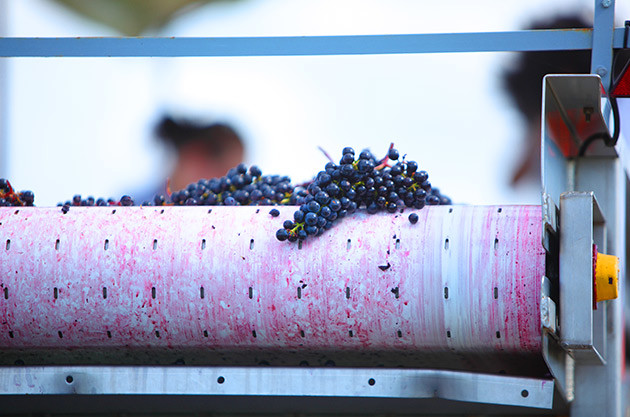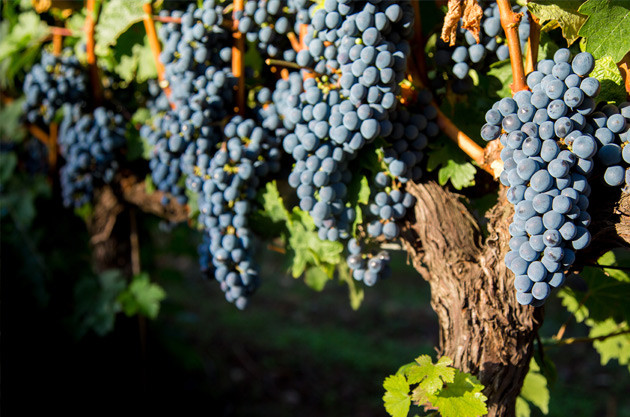The Blend
The third session starts with tasting three glasses of wine – a Cabernet Sauvignon from Margaux, Bordeaux, France, a Merlot from Pomerol AOC, and a Cabernet-Merlot blend from New Zealand’s Hawke’s Bay. After tasting and comparing the three glasses, I come to understand why Cabernet Sauvignon and Merlot can become good partners – while Cabernet Sauvignon gives tannin, acidity and aroma, Merlot enhances body and alcohol – like a musical duet with a tenor and a soprano.

Cabernet Sauvignon and Merlot are often grown together. Both Cabernet Sauvignon and Merlot require moderate or hot climate to ripe properly.
Regions
Bordeaux
Premium Cabernet Sauvignon and Merlot regions include Bordeaux, particularly the Left Bank and the Right Bank. The Left Bank at west and south of the Gironde and Garonne has three major appellations, namely Médoc, Haut-Médoc (which includes the communes Pauillac, Margaux, St-Julien and Saint-Estèphe), and Graves (including the commune Pessac-Leognan). The Left Bank is particularly renowned for Cabernet Sauvignon, which presents high levels of tannin and acidity, medium alcohol, and can be aged for many years. In general Cru Classé chateaux produce the very finest wines and they have prices to match the quality.
The Right Bank at the north and east of the Gironde and Dordogne has two most important appellations, namely Saint-Émilion AOC (with its best wines labelled as Premier Grand Cru Classés A) and Pomerol AOC. The dominant variety at the Right Bank is Merlot, presenting medium tannin, medium acidity, and tender notes of red fruit and plum.
Besides the wines from the most prestigious appellations, many fine wines from Bordeaux, labelled as Bordeaux AOC or Bordeaux Supérieur AOC (which usually has higher level of alcohol than Bordeaux AOC), are blends of Cabernet Sauvignon and Merlot.
Rest of the World
Australia’s Coonawarra and Margaret River have emerged as two classic regions for Cabernet and Merlot. Coonawarra Cabernet Sauvignon has unique minty and eucalyptus flavours, while Margaret River’s Cabernet and Cabernet-Merlot blends have high tannin levels with blackcurrant flavour.
New Zealand’s Hawke’s Bay produces high-quality Cabernet-Merlot blends. They usually have blackcurrant leaf aromas accompanied by cedar complexity from oak.
USA’s Napa Valley, including the Rutherford and Oakville districts, and Sonoma’s Alexander Valley are premium Cabernet Sauvignons regions. Their wines typically have high levels of tannin and oak flavours (after tasting some USA’s Cabernet Sauvignon, my first impressions were that Californian oak-treated flavours are more dairy-like, vanillin, soft and smooth while French oak-treated flavours are more cedar, coffee and tobacco).
Premium-quality Cabernet Sauvignon and Merlot varietal and blended wines are also produced in Chile, particularly Maipo Valley, Colchagua and Colchagua.
Argentina’s Mendoza has very good vineyard sites of high altitude, which are good conditions for growing the country’s best red wines.
South Africa’s Stellenbosch produces wines that taste similar to those from Bordeaux which have higher levels of tannin and acidity with notes of herbs.
Entry Level
As Cabernet Sauvignon and Merlot are international varieties that are widely grown, bulk production, inexpensive wines made from the two varieties or their blends are easily found. Chile’s Central Valley, France’s Pays d’Oc IGP, South Africa’s Western Cape, South Eastern Australia, USA’s California and Argentina’s Mendoza are major regions for inexpensive red wines.
Inexpensive, light-bodied Merlot from Northern Italy are easily found in the Chinese market and they are especially popular among female consumers who prefer not to have wines of high tannin. However, more consumers who have been exposed to the complexity and long finish of high-but-soft tannin wines, especially of high quality, pure Cabernet Sauvignon, are embracing tannin and disposing of the old notion that high-tannin only means austerity.
Click to learn more about available WSET courses in China>>
Translated by Nina Fan Feng / 冯帆
All rights reserved by Future plc. No part of this publication may be reproduced, distributed or transmitted in any form or by any means without the prior written permission of Decanter.
Only Official Media Partners (see About us) of DecanterChina.com may republish part of the content from the site without prior permission under strict Terms & Conditions. Contact china@decanter.com to learn about how to become an Official Media Partner of DecanterChina.com.











Comments
Submit